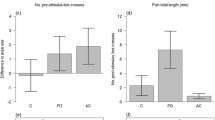Synopsis
Shoals of 3, 5, 7, 10, 15, and 20 bluntnose minnows,Pimephales notatus, were allowed to forage in the absence and presence of a fish predator, which was separated from the shoal by a clear plexiglass partition. A typical dilution effect was observed in that individual fish in larger shoals were approached less frequently by the predator. In the absence of a predator, foraging latency decreased significantly and the rate of foraging increased with increasing shoal size. Foraging latency for each shoal size tended to increase in the presence of a predator and foraging rate decreased, significantly for shoals of 7, 15, and 20 fish. Members of larger shoals were safer and enjoyed a greater level of food consumption, perhaps due to decreased individual vigilance for predators and social facilitation. However, foraging effort decreased when a predator was present, as more time was allocated to predator avoidance.
Similar content being viewed by others
References cited
Allen Ray, A. 1982. SAS user's guide: statistics. 1982 Edition. SAS Institute Inc. Cary, North Carolina. 584 pp.
Bertram, B.C.R. 1980. Vigilance and group size in ostriches. Anim. Behav. 28: 278–286.
Crook, J.H. 1965. The adaptive significance of avian social organizations. Symp. Zool. Soc. Lond. 14: 181–218.
Dill, L.M. 1974. The escape response of the zebra danio (Brachydanio rerio). I. The stimulus for escape. Anim. Behav. 22: 711–722.
Eggers, D.M. 1976. Theoretical effect of schooling by planktivorous fish predators on rate of prey consumption. J. Fish. Res. Board Can. 33: 1964–1971.
Giraldeau, L.A. 1984. Group foraging: the skill pool effect and frequency-dependent learning. Amer. Nat. 124: 72–79.
Godin, J.-G. & M.J. Morgan. 1985. Predator avoidance and school size in a cyprinodontid fish, the banded killifish (Fundulus diaphanus Lesueur). Behav. Ecol. Sociobiol. 16: 105–110.
Hamilton, W.D. 1971. Geometry for the selfish herd. J. Theor. Biol. 31: 295–311.
Holmes, W.G. 1984. Predation risk and foraging behavior of the hoary marmot in Alaska. Behav. Ecol. Sociobiol. 15: 293–301.
Krebs, J.R., M.H. MacRoberts & J.M. Cullen. 1972. Flocking and feeding in the great titParus major an experimental study. Ibis 114: 507–530.
Lazarus, J. 1979. Flock size and behaviour in captive red-billed weaverbirds (Quelea quelea): implications for social facilitation and the functions of flocking. Behaviour 71: 127–145.
Lendrem, D.W. 1983. Predation risk and vigilance in the blue tit (Parus caeruleus). Behav. Ecol. Sociobiol. 14: 9–13.
Lendrem, D.W. 1984. Flocking, feeding and predation risk: absolute and instantaneous feeding rates. Anim. Behav. 32: 298–299.
Magurran, A.E. & T.J. Pitcher. 1983. Foraging, timidity and shoal size in minnows and goldfish. Behav. Ecol. Sociobiol. 12: 147–152.
Magurran, A.E., W. Oulton & T.J. Pitcher. 1985. Vigilant behaviour and shoal size in minnows. Z. Tierpsychol. 67: 167–178.
McKaye, K.R., D.J. Weiland & T.M. Lim. 1979. Comments on the breeding biology ofGobiomorus dormitor (Osteichthyes: Eleotridae) and the advantage of schooling behavior to its fry. Copeia 1979: 542–549.
Milinski, M. 1977. Do all members of a swarm suffer the same predation? Z. Tierpsychol. 45: 373–383.
Milinski, M. 1986. Constraints placed by predators on feeding behaviour. pp. 236–252. In: T.J. Pitcher (ed.) The Behaviour of Teleost Fishes, Croom Helm, London.
Morgan, M.J. & J.-G.J. Godin. 1985. Antipredator benefits of schooling behaviour in a cyprinodontid fish, the banded killifish (Fundulus diaphanus). Z. Tierpsychol. 70: 236–246.
Neill, S.R.St.J. & J.M. Cullen. 1974. Experiments on whether schooling by their prey affects the hunting behaviour of cephalopods and fish predators. J. Zool. Lond. 172: 549–569.
Ohguchi, O. 1981. Prey density and selection against oddity by three-spined sticklebacks. Z. Tierpsychol. Suppl. 23: 1–79.
Pitcher, T.J. 1986. Functions of shoaling behaviour in teleosts. pp. 294–337. In: T.J. Pitcher (ed.) The Behaviour of Teleost Fishes, Croom Helm, London.
Pitcher, T.J., A.E. Magurran & T.J. Winfield. 1982. Fish in larger shoals find food faster. Behav. Ecol. Sociobiol. 10: 149–151.
Scott, W.B. & E.J. Crossman. 1973. Freshwater fishes of Canada. Fish. Res. Board Can. Bull. 184, Ottawa. 966 pp.
Seghers, B.H. 1981. Facultative schooling behavior in the spottail shiner (Notropis hudsonius): possible costs and benefits. Env. Biol. Fish. 6: 21–24.
Shaw, E. 1969. Some new thoughts on the schooling of fishes. In: FAO Fish. Rept. No. 62, Vol. 2: 217–231. Proc. FAO Conf. on Fish Behav. in Relation to Fishing Techniques and Tactics, Bergen.
Street, N.E., A.E. Magurran & T.J. Pitcher. 1984. The effects of increasing shoal size on handling time in goldfishCarassius auratus L. J. Fish Biol. 25: 561–566.
Treherne, J.E. & W.A. Foster. 1980. The effects of group size on predator avoidance in a marine insect. Anim. Behav. 28: 1119–1122.
Treherne, J.E. & W.A. Foster. 1981. Evidence for the dilution effect in the selfish herd from fish predation on a marine insect. Nature 293: 466–467.
Turner, G.F. & T.J. Pitcher. 1986. Attack abatement: a model for group protection by combined avoidence and dilution. Amer. Nat. 128: 228–240.
Author information
Authors and Affiliations
Rights and permissions
About this article
Cite this article
Morgan, M.J., Colgan, P.W. The effects of predator presence and shoal size on foraging in bluntnose minnows,Pimephales notatus . Environ Biol Fish 20, 105–111 (1987). https://doi.org/10.1007/BF00005290
Received:
Accepted:
Issue Date:
DOI: https://doi.org/10.1007/BF00005290




